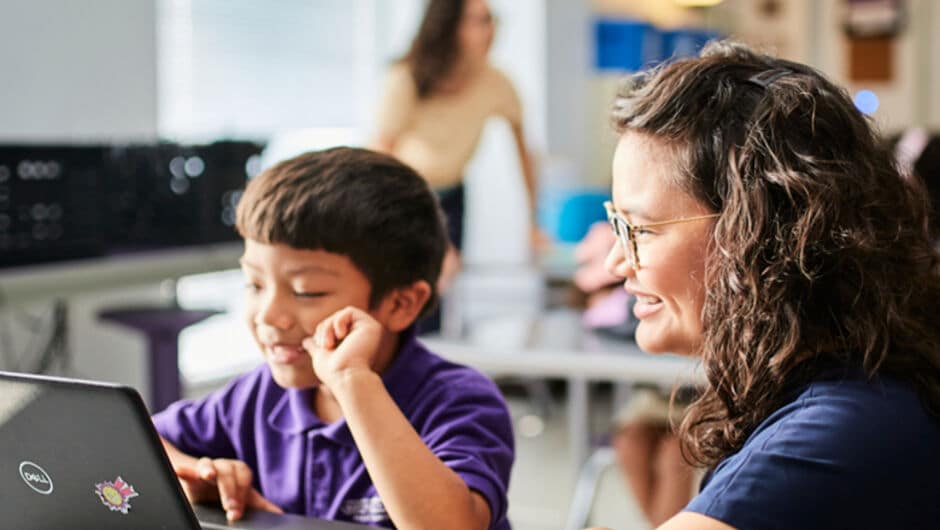
To Reduce Absenteeism, Educators Focus on Relationships
School officials are focusing on personal connections to students and families to boost attendance for online classes.
Michael Coleman and Breana McMillon regularly drive to students’ homes to deliver meals, troubleshoot tech problems, or exchange devices. The two “support humans,” as they’re known on their KIPP Kansas City campus, have seen their roles change significantly during the coronavirus pandemic.
Many families of students enrolled at the school rely on public transportation, McMillon said, and it’s often difficult for families to go to the campus to pick up computers or hotspots. Without home visits from school staff, those families would also lack help for devices that break or malfunction.
It’s “not just about giving the basics,” said Coleman, who is a wellness coach. The goal is also to check in with students to let them know people at their school care about them and want them online, he said. Coleman often asks students to show him their study spaces or helps to troubleshoot tech issues on routine home visits to deliver resources.
The at-home support is part of an effort to ensure students are staying connected and engaged even if they are not physically in school. Attendance is important to students’ academic success, and there is concern about widening academic gaps between students during the pandemic.
Bellwether Education, a national nonprofit organization, estimated in October that as many as 3 million of the nation’s “most educationally marginalized students” might not have experienced any formal education since school buildings closed that spring. Those students may have lacked the devices and internet access needed for remote instruction. But they also may have faced other challenges: language barriers or disabilities for which they received no accommodations; homelessness or housing instability; abuse or neglect; or increased responsibilities at home such as childcare or having to work.
Kendra Oatis, a counselor at Charlestown Middle School in Indiana, noticed low engagement among students she teaches in virtual classes. “They were doing their work, but I didn’t feel like I had a good idea of how they were doing,” she said. So she set up required five-minute virtual face-to-face meetings with each student. Using the online scheduling app Calendly, Oatis’s students add appointments to her calendar.
Engagement increased, Oatis said, in part because students were told they could not pass her class if they skipped the meeting. She also learned more about the challenges her students faced.
“I found out one of my students had had COVID. Because they’re online, they don’t have to tell us,” she said.
She also learned that, in many cases, it had taken students a quarter of the semester to learn how to use their Chromebooks and the apps required for their classes.
Redefining ‘Present’
Chronic absenteeism—when students miss at least 15 days of a school year, according to the U.S. Department of Education—predates the pandemic. Thirty-six states and the District of Columbia have identified chronic absenteeism as a key metric to track in their Every Student Succeeds Act accountability plans to improve student success. Many are working to adjust the way this metric is calculated in the midst of the global pandemic.
States such as California and Florida have adopted “hold harmless” policies that allow districts and schools to count the pre-pandemic average daily attendance for their funding this school year. In Illinois, attendance funding for the 2020-2021 school year is based on the greater of either the previous year’s daily average, or the last three school years. Still, research shows attendance as a key indicator of student success, and while states are finding workarounds for their funding models, there is still great concern that academic gaps between students may widen while they’re unable to physically attend school.
“We know it’s a challenge for students to be on screen all day. They’re going through a global pandemic on top of the regular stress of being a high school student.”
The unusual circumstances of the current school year are prompting some administrators to be more flexible about what constitutes class attendance.
In Michigan, districts are required to show one two-way interaction per week—email, phone calls, instant messages, and face-to-face conversations all count toward this metric. Other districts have also followed a similar pattern to count students as present included assignment completion as a measure of attendance, even if students didn’t log into synchronous learning times.
In other cases, districts are redefining the traditional school calendar. The Oklahoma State Board of Education voted in May to allow schools to hold classes on Saturdays as an emergency option for districts hoping to reach students who can’t make virtual classes during the week. And KIPP New Jersey has implemented a night kindergarten virtual session to allow working parents to support their young learners after work hours.
“Consistency is key with our families,” McMillon said.
“There are so many students who are giving up, throwing in the towel,” she said, and some students have grown frustrated with the challenges of virtual learning, instead of realizing they’re not struggling alone. School staff have to demonstrate to students that they care about more than just how students are doing in school, she said.
Attendance Works, a national nonprofit that focuses on reducing chronic absence, recommends that school districts and policy makers consider more than the traditional roll count as a metric of student attendance and engagement this year. Instead, the organization suggests that school leaders track contact, connectivity, relationships, and participation as indicators of whether students are successfully engaging in learning.
Portland Public Schools in Oregon uses an attendance dashboard to provide early intervention and support for students who are struggling to log into virtual classes. The district uses family resource centers and offers limited in-person instruction to help meet the needs of families who are struggling with connectivity issues, said Karen Werstein, the district’s public information officer. That’s true even after distributing thousands of Chromebooks and Wi-Fi hotspots, she said.
“The district’s in-person learning and attendance strategies are targeted to the root cause and the individual needs of the student,” Werstein said. The strategies might include more check-ins with support staff, social-emotional focused community building in classes, and texting students to ensure they understand their work and to encourage them to attend school.
Finding a Different Way Forward
Despite the challenges of living through a pandemic, some school leaders insist on tracking students’ grades and assigning punitive consequences—a rigid stance that frustrates some teachers.
“We’ve had all this time in the world for people’s hearts and philosophies to change toward it, and they haven’t,” Oatis said. “I have little patience for trying to teach teachers how to like children.”
Without that basic trait, she said, “how are you doing this career, and how is this fulfilling to you?”
National data show teacher effectiveness is a top factor in student success, and much of that boils down to relationships. If it’s difficult for educators to reach students now, some experts say, it’s likely an indicator that the students were only physically present before the pandemic.
For Shaamar Samuel, associate dean of students at Excel Academy in Boston, home visits have been critical to assessing the needs of students and their families and reinforcing the idea that the school is a part of their extended village.
“Engagement and attendance are interrelated,” he said.
“We know it’s a challenge for students to be on screen all day. They’re going through a global pandemic on top of the regular stress of being a high school student.”
They can’t eliminate screen time, but the Excel staff has worked to implement virtual student clubs and activities to help students form connections outside of academics. The 11th grade dean, for example, created an app students can use to play games, chat with each other, and get important alerts and announcements about their classes. The 12th grade dean worked with the school’s antiracist coordinator to organize virtual spaces for students and teachers to discuss issues of empathy and compassion. There also are biweekly advisory challenges for students to compete on Kahoot or do TikTok challenges.
Each week, students produce a video highlighting different classmates as well as their interests and activities. It’s impressive to watch the students who are in leadership positions, Samuel said. “We weren’t expecting them to be as engaged and as forthcoming as they have been,” he said, but “we’ve seen students take up this extra leadership. They’ve said, ‘We see that there’s this global pandemic going on, we know that teachers and administrators are working hard and have a lot going on, and we’re going to really step up in any way we can.’”
School leaders set an attendance rate goal of 90% to 95%, and they’ve hit the target, Samuel said.
That success takes a lot of effort and creativity. For example, on a recent home visit, Samuel and one of the school’s social workers dropped off food for a student’s family before taking a walk with him and treating him to ice cream. What likely felt informal to the student, was actually a highly structured and multi-layered intervention and engagement method designed to inform the educators about the student’s academic progress and social life as well as an opportunity to offer additional support.
A best practice is to “treat student absenteeism as a problem to be solved, not a behavior to be punished," according to Attendance Works.
That means taking a trauma-informed approach to every interaction, acknowledging the struggles families and educators are experiencing and a need “to move gently and gingerly,” Coleman said. “We want happy and healthy families and students and we want them to be educated.”
We want your feedback. Share your thoughts on this story or suggest other stories for us to pursue.
Sign up to receive articles like this in your inbox!
Thanks for signing up!
Content is loading...







